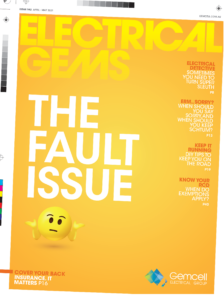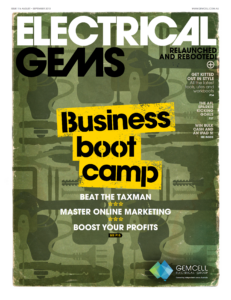Out Now
The Aussie Issue
Current Issue
The Aussie Issue
DEC 25 - JAN 26

E-sports is fast emerging as a true rival to traditional sport across the globe – and it’s something that, statistically, 75 per cent of your customer base is into. But what’s the potential for e-sports?
Think e-sports, and many of us will hark back to people playing computer games against each other – from the classic Shane Warne Cricket 1999 (RIP, Warney) to the ever popular FIFA series of soccer games.
Unsurprisingly, it’s developed a lot since those early days, and today e-sports is big, big business – and it’s only going to get bigger. In fact, it’s the fastest-growing sports category in the world.
By 2024, it’s estimated that there’ll be almost 600 million e-sports enthusiasts and occasional viewers. In 2021, the global e-sports market was valued at more than $1bn.
This is serious stuff. And all you need is some half-decent equipment and a strong internet connection.
Sean Callanan is a sports pro with a proven track record in the industry, having worked with professional clubs around the world on their digital strategies before becoming involved in e-sports. Now the owner of e-sports club Gravitas, Callanan says the parallels with traditional sports are evident.
“In traditional sports there’s a whole bunch of different types of sports – cricket, NRL, AFL and the like. The sports we watch at the pro level are right at the very top, but there are millions of people playing them underneath that.
“So, in gaming analogy, you can play a whole bunch of different video games. You can play Fortnite, you can play League of Legends, you can play Call of Duty – millions of people are playing the game. But at the very top the best players compete against each other.
It’ll come as no surprise to many of us that, from a population in excess of 26 million people, 18 million Aussies currently play video games.
And, anyone who’s had any exposure to YouTube can’t have failed to have seen the volume of gamer content on there. The market’s huge.
Of the 18 million of us who enjoy playing video games, however, a couple of million, says Callanan, are already e-sports fans. They enjoy watching other people – the best of the best – compete.
“As the eyeballs grow, and the fans grow, then it becomes a little bit more like professional sports.
“Fans are watching it, consuming it in a different way. Fifteen years ago, 30, 40 years ago, you might have grown up watching footy, watching soccer or cricket, idolising those athletes, and following those sports, and you did it via the traditional methods of TV and radio and print.
“Today’s generation are watching their favourite gamers on Twitch and on YouTube, and following them on social media.”
And, when you think about it logically, it makes total sense, doesn’t it? If you enjoy playing cricket for your local side, you’re not going to be averse to watching an Ashes test match, right?
So, teams play each other online in a variety of different e-sports, in a variety of different formats. Different video games have different competitions and different ways of operating.
In Australia, the LCO (League of Legends Circuit Oceania) is a League of Legends comp that plays twice a week for ten weeks, for two splits – seasons – in a year.
People tune in on Twitch, and winning the league can lead to great, great things.
“There’s the option, if you win the league, to go into the World Championship – and 300 million people watch the League of Legends World Championship,” says Callanan.
“There are multiple leagues around the world, so it’s an ecosystem.”
And it’s an ecosystem that’s becoming very profitable.
Here in Australia, for example, the LCO has attracted Menulog as a major sponsor, and the major events don’t just attract an online audience, but an in-person audience too.
“Fifteen years ago, the World Championship Final for the League of Legends was held in a hall in LA. Ten years ago, it was a big thing to fill out the Staples Center [now the Crypto.com arena] there.
“Now, they fill these big stadium events.”
And bringing that gaming experience into the physical world has some positive spin-offs too.
“I still fondly remember sitting next to a young son and his dad.
“They were watching the game, and the boy was commenting he couldn’t understand why people were cheering and yelling because he’d always watched on Twitch and just followed the chat.
“So he was learning about the live experience that traditional sports fans are familiar with.
“But then also, it becomes a shared experience – parents can attend an esports game that their son or daughter is into, and it’s another interest point.”
In much the same way as mainstream sports teams identify new recruits, esports teams conduct scouting and hold local tryouts. Players are developed by coaches, and with the ultimate aim of honing their skills sufficiently to play on the international stage.
For now, however, competing from Australia against teams based overseas is problematic, due to internet connections.
While the country’s internet network is good enough to support domestic competition, it’s too slow to compete globally.
“The ping speed is too long,” explains Callanan.
“You press a button and it tells the computer to do something, and then by the time someone else sees it they’ve already moved.”
While a true Olympic–style esports competition is problematic to arrange due to the various game owners around the world, and no governing federation, Callanan is certain esports has a huge, huge future – with significant opportunity for traditional sports teams, too.
“There’s a way for sports teams to get into the world of gaming, and engage fans through gaming – be it players playing against fans or members of the club – and that would create some opportunities for engagement and sponsorship.
“After all, 75 per cent of Australians play video games, so that means 75 per cent of sports fans do, too.”
And, when you think about it, 75 per cent of your customer base.
Keep up to date with our latest news and competitions by subscribing to our regular newsletter.

Issue 189
OCT - NOV 2025

Issue 188
AUG - SEPT 2025

Issue 187
JUN - JUL 2025

Issue 186
APR - MAY 2025

Issue 185
FEB - MAR 2025

Issue 184
DEC 2024 - JAN 2025

Issue 183
OCT - NOV 2024

Issue 182
AUG - SEPT 2024

Issue 181
JUN - JUL 2024

Issue 180
APR - MAY 2024

Issue 179
FEB - MARCH 2024

Issue 178
DEC 2023 - JAN 2024

Issue 177
OCT - NOV 2023

Issue 176
AUG - SEPT 2023

Issue 175
JUN - JUL 2023

Issue 174
APR - MAY 2023

Issue 173
FEB - MAR 2023

Issue 172
DEC 2022 - JAN 2023

Issue 171
OCT - NOV 2022

Issue 170
AUG - SEPT 2022

Issue 169
JUN - JUL 2022

Issue 168
APR - MAY 2022

Issue 167
FEB - MAR 2022

Issue 166
DEC 2021 - JAN 2022

Issue 165
OCT - NOV 2021

Issue 164
AUG - SEPT 2021

Issue 163
JUN - JUL 2021

Issue 162
APR - MAY 2021

Issue 161
FEB - MAR 2021

Issue 160
DEC 2020 - JAN 2021

Issue 159
OCT - NOV 2020

Issue 158
AUG - SEPT 2020

Issue 157
JUN - JUL 2022

Issue 156
APR - MAY 2020

Issue 155
FEB - MAR 2020

Issue 154
DEC 2019 - JAN 2020

Issue 153
OCT - NOV 2019

Issue 152
AUG - SEPT 2019

Issue 151
JUN - JUL 2019

Issue 150
APR - MAY 2019

Issue 149
FEB - MAR 2019

Issue 148
DEC 2018 - JAN 2019

Issue 147
OCT - NOV 2018

Issue 146
AUG - SEPT 2018

Issue 145
JUN - JUL 2018

Issue 144
APR - MAY 2018

Issue 143
FEB - MAR 2018

Issue 142
DEC 2016 - JAN 2017

Issue 141
OCT- NOV 2017

Issue 140
AUG - SEPT 2017

Issue 139
JUN - JUL 2017

Issue 138
APR - MAY 2017

Issue 137
FEB - MAR 2017

Issue 136
DEC 2016 - JAN 2017

Issue 135
OCT - NOV 2017

Issue 134
AUG - SEPT 2016

Issue 133
JUN - JUL 2016

Issue 132
APR - MAY 2016

Issue 131
FEB - MAR 2016

Issue 130
DEC 2015 - JAN 2016

Issue 129
OCT - NOV 2015

Issue 128
AUG - SEPT 2015

Issue 127
JUN - JUL 2015

Issue 125
APR - MAY 2015

Issue 125
FEB - MAR 2015

Issue 124
DEC 2014 - JAN 2015

Issue 123
OCT - NOV 2014

Issue 122
AUG - SEPT 2014

Issue 121
JUN - JUL 2014

Issue 120
APR - MAY 2014

Issue 119
FEB - MAR 2014

Issue 118
DEC 2013 - JAN 2014

Issue 117
OCT - NOV 2013

Issue 116
AUG - SEPT 2013

Comments (0)
Write a Comment